Learning Objectives
- Tensorboard
- Validation Set
- Overfitting and Underfitting
- Bias and Variance
- Techniques to avoid Overfitting - Early Stopping, Regularization, Dropout
Optimizing a Neural Network
Optimizing a Neural Network, or any model for that matter, is like tuning a radio. The difference is there might be a million knobs to tune simultaneously. Let's have a look at all the knobs one by one.

Tensorboard
TensorBoard: TensorFlow's visualization toolkit
TensorBoard provides the visualization and tooling needed for machine learning experimentation:
- Tracking and visualizing metrics such as loss and accuracy
- Visualizing the model graph
- Viewing histograms of weights, biases, or other tensors as they change over time
- Displaying images, text, and audio data
And much more!
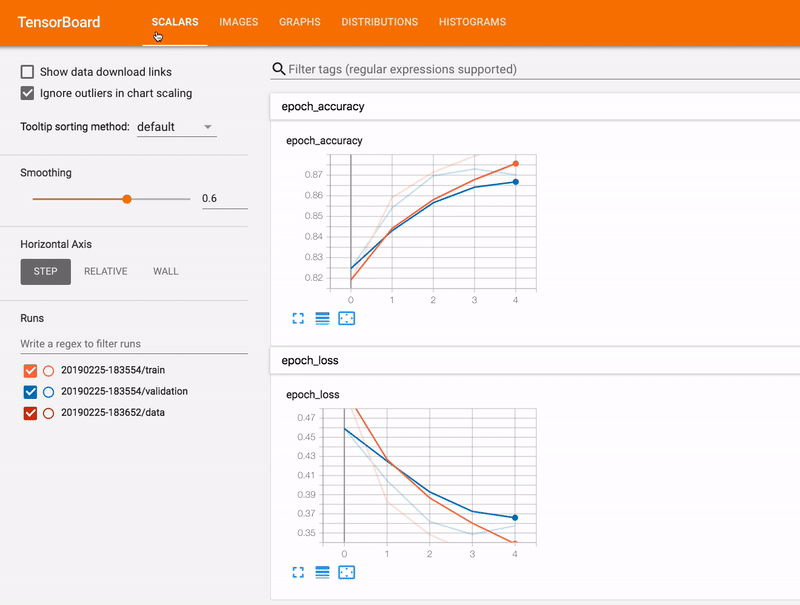
Train, Validation & Test Set
- Training Dataset: The sample of data used to fit (train) the model.
- Validation Dataset: The sample of data used to evaluate the model's performance while tuning model hyperparameters.
- Test Dataset: The sample of data used for the final evaluation of the model's performance

Overfitting and Underfitting
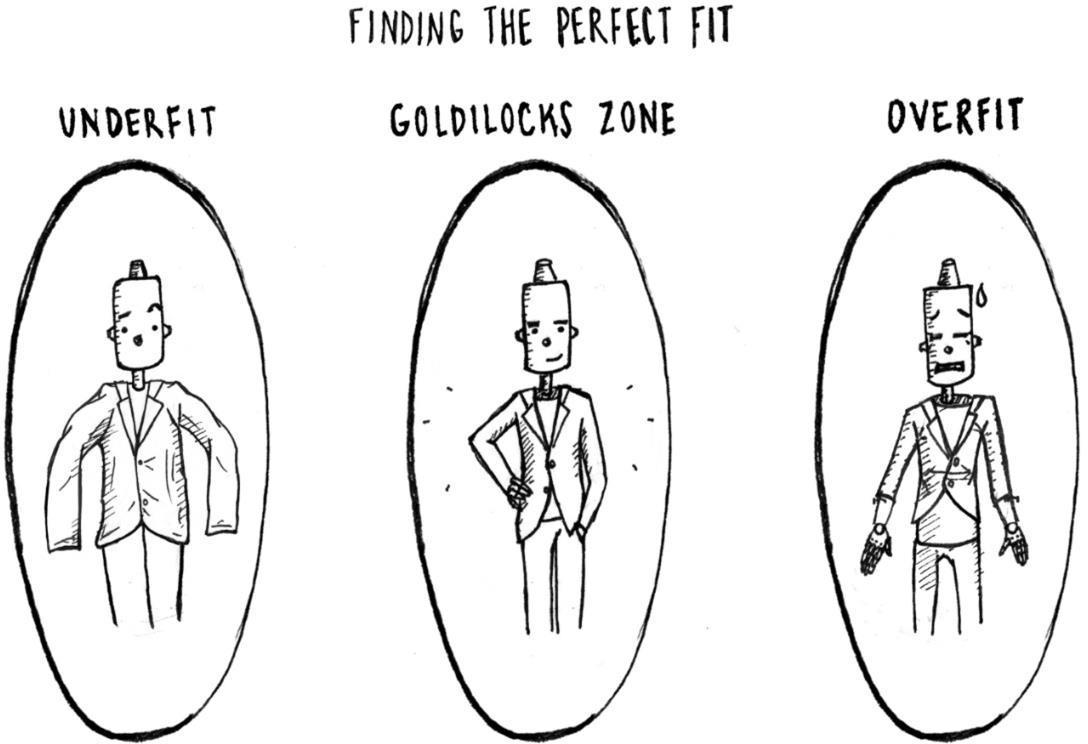
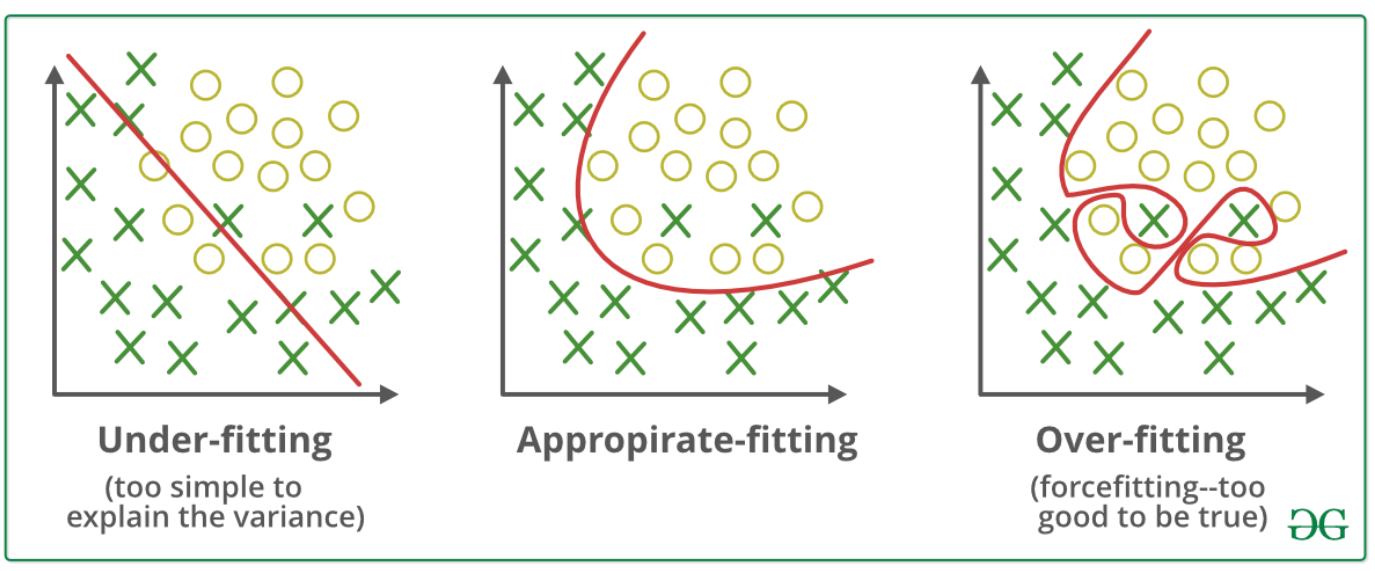
Overfitting
Overfitting is a scenario where your model performs well on training data but poorly on data not seen during training.
This means that your model has memorized the training data instead of learning the relationships between features and labels.
Imagine getting a 'too good to be true' accuracy on training data but a bad accuracy on test/validation data. That's overfitting for you.
Underfitting
A machine learning algorithm is said to have underfitting when it cannot capture the underlying trend of the data.
You can think of underfitting to be the opposite of overfitting.
Overfitting learns the training data TOO well whereas Underfitting is not able to learn the data sufficiently well.
Imagine neither getting a good accuracy in training data nor test/validation data. That's underfitting for you.
Bias and Variance
Bias and Variance in real world
In dictionary terms:
Bias: Prejudice in favor of or against one thing, person, or group compared with another, usually in a way considered to be unfair.
Variance: The state or fact of disagreeing or quarreling.
In short, bias represents how unfair is something toward others, and Variance represents how likely something changes with respect to others.
Confusing? Worry not. The next example will clarify all your doubts.
Example
Let's assume you have called two weather examiners, Mr. Bishop and Mr. Varian, to test if it will rain or not.
Mr. Bishop loves rain a lot. And Mr. Varian is a bookworm.
Let us talk about the conditions for rain.
- It rains only if it's a little humid.
- It does not rain if it's windy, hot, or freezing.
Mr. Bishop represents bias.
You ask Mr. Bishop (Despite his training, he is too biased toward rain):
Me: Sir, it's extremely hot out here. Will it rain?
Mr. Bishop: Yup.
Me: Sir, it's a bit windy. Will it rain?
Mr. Bishop: Maybe not.
Me: Sir, it's freezing. Will it rain?
Mr. Bishop: Yes, of course.
Me: Sir, it's a little humid. Will it rain?
Mr. Bishop: Damn sure.
Did you notice that Mr. Bishop is highly Biased towards the chances of having rain? During the test, he is unable to predict most of them correctly.
This condition is called underfitting.
Mr. Varian represents Variance.
Now let us see your conversation with Mr. Varian (a bookworm who completely remembers the training he had ):
Me: Sir, it's extremely hot out here. Will it rain?
Mr. Varian: Nope.
Me: Sir, it's a little windy. Will it rain?
Mr. Varian: No way.
Me: Sir, it's freezing. Will it rain?
Mr. Varian: No way. Me: Sir, it's a little humid. Will it rain?
Mr. Varian: Yes, it will.
Mr. Varian successfully predicted whether it would rain or not. But being a bookworm, Mr. Varian is unknown to the conditions not described in the book during training.
Now, we ask Mr. Varian :
Me: Sir, a giant who lost his candy is sitting on the cloud. Will it rain?
Mr. Varian: Not sure; since the answer is "No" to most of the conditions, there is a high possibility that it will not rain.
Now, although the decision of Mr. Varian varies perfectly with the input conditions, he cannot predict the new and unseen conditions (other general conditions apart from the given specific conditions while training).
This condition is called overfitting. And it offers poor generalizability.
High Bias or High Variance?
Then what is better, high bias (high generalizability) or high Variance (high accuracy on training data)?
Well, the answer is, "Best of both worlds". We neither need neither high bias nor high Variance. We would want our algorithm to perform better on the training set and offer the best result on unseen data (the test set).
In general, having high bias reduces the algorithm's performance on the training set, while having high Variance reduces performance on unseen data.
This is known as Bias-Variance Trade-off.
Strategies to avoid overfitting
You can combat overfitting by reducing the complexity of your model (i.e., reducing the number of parameters). This is done by:
- Using fewer layers (shallower networks), fewer neurons per layer (narrow networks)
- Using Dropouts
- Using Regularisation
- Early Stopping in some cases
We'll learn about all the above 'technical' terms in the upcoming units.
Underfitting is a bit harder to diagnose.
Increasing the complexity of your model, i.e., increasing layers and number of neurons, can help combat underfitting.
With more layers, the network can learn more sophisticated relationships and perform better on difficult real-world tasks.
Tackling Overfitting using Early Stopping, Regularization, and Dropouts
Early Stopping
When training a large network, there will be a point during training when the model will stop generalizing and start memorizing or learning the noise in the training dataset, i.e., it will start overfitting, which results in bad performance when the model is exposed to the unseen new dataset.
In other words, this overfitting of the training dataset will increase the generalization error (model unable to work well on validation/test data), making the model less useful for making predictions on new data.
The challenge is to train the network long enough for it to learn the mapping from inputs to outputs, but training should not be for so long that it overfits the training data.
Regularization
Regularization is a technique that makes slight modifications to the learning algorithm such that the model generalizes better (Generalization refers to your model's ability to adapt properly to new, previously unseen data). This, in turn, improves the model's performance on the unseen data.
Remember when we added more layers to the model (making it more complex)? Adding more than the required layers might also lead to overfitting.
Looking at the graph below, can you guess what the ideal model complexity should be?
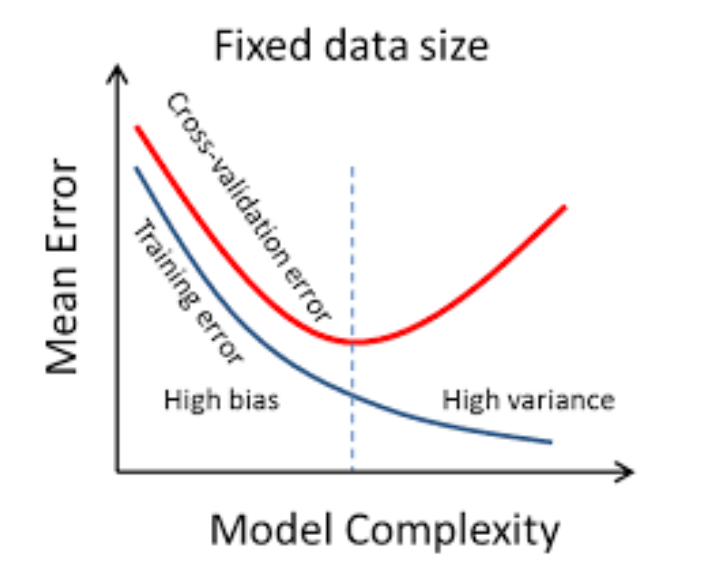
Dropout - An Analogy
Consider a TV show consisting of a participant, a group of audience, and a show host. The show works as follows:
- At the beginning of the game, the host selects a random unseen movie to be the main target of the event.
- At each stage, the host shows a short clip from the selected movie, then asks a question about the movie's events so far.
- Each one of the audience will answer, and the participant has to pick one answer from the audience.
- If the answer is correct, the participant and the chosen person from the audience will get 50$ each.
- If the answer is wrong, they both have to pay 100$.
Suppose the participant notices that one of the audience is always giving the correct answer. With time, the participant will build trust with this person and neglect the solutions the others provide.
There are some problems with this strategy.
- The trusted person may be good with the question categories in the early stages but very bad with the ones in the later stages of the game.
- If only one person (or a small group) is always selected, other people from the audience will feel left out and will not care to pay attention to the played video clip anymore.
- This way — at later stages — the trusted person will no longer be helpful, and other people from the audience who stopped paying attention will already lose the sequence of events to answer correctly.
Therefore, relying only on one person is bad, and it will lead to losing a lot of money.
How do you think we could manage to fix this problem?
One smart strategy is to always give a chance to others.
- This way, the participant will learn the strength of each audience member and know which one to ask based on the question category.
- In addition, everyone will always feel responsible and obliged to pay attention.
Dropout in Neural Network
You may ask what this has to do with neural networks? Well, let us consider the following network:

We could think of
- the input layer (in green) as the question the host is asking,
- each neuron in the hidden layer (in blue) as one person from the audience,
- and the output layer (in red) as the chosen answer from one selected audience.
If the output layer finds out that a specific neuron is always giving the best answer, it may neglect the others and give all the weight to this neuron.
Based on our previous analysis, we chose to forbid some neurons from answering and giving a chance to others. This way, we will achieve balance and force all neurons to learn.
This is the concept of dropout, and technically it works as follows:
- We assign a dropout rate, which represents the percentage of neurons to drop (e.g., 20% of neurons)
- At each stage, we remove random neurons according to the predefined percentage.
- We calculate the final output according to the combination of results from the remaining neurons.
With this technique, all neurons will have the chance to vote and will be obliged to answer correctly to decrease the model loss.
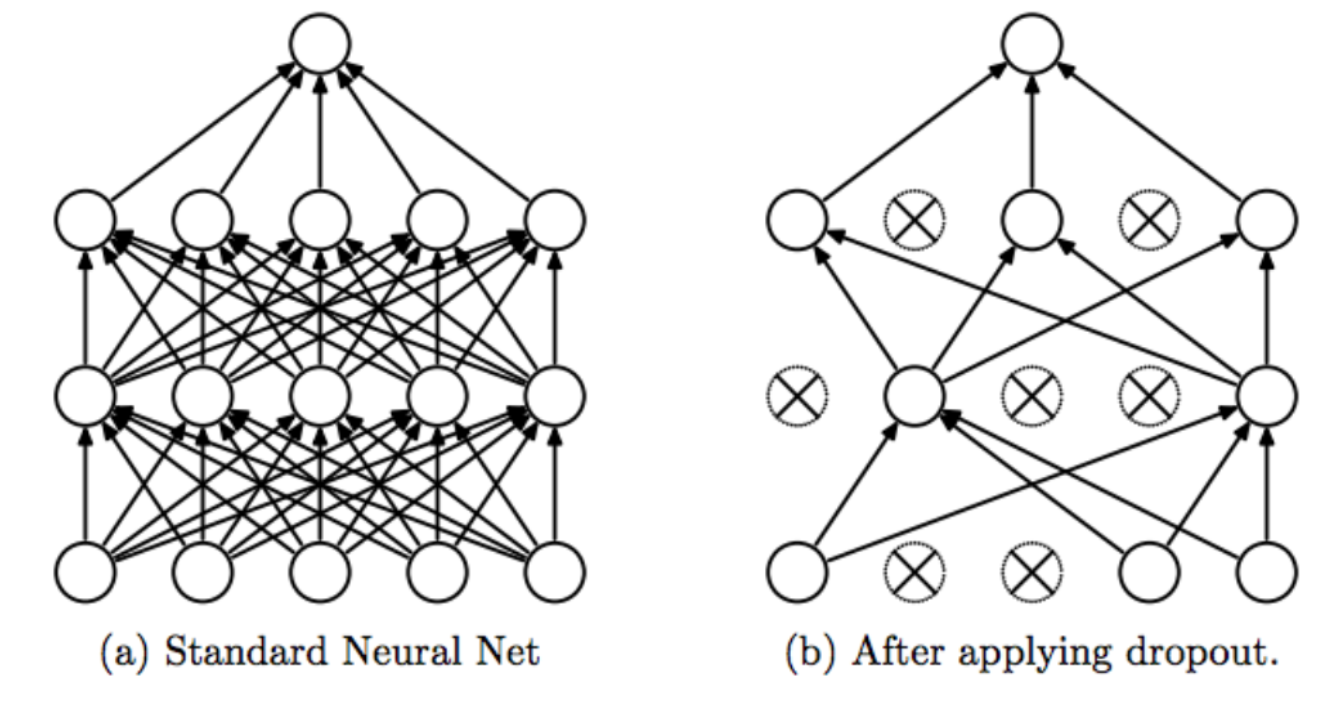
In Deep Neural Networks, the chances of overfitting are very high. Therefore, Dropout acts as a regularization to the NN. It makes the model more robust.
The percentage of neurons to be dropped is a hyperparameter that can be tuned based on the amount of overfitting.
By dropping a unit out, we mean temporarily removing it from the network, along with all its incoming and outgoing connections.
It can be used with most layers, such as dense, fully connected layers. Dropout may be implemented on any or all hidden layers in the network as well as the visible or input layer.
NOTE: It is not used on the output layer.
Let's understand Regularization and Dropout practically
Notebook - Optimizing a Neural Network
- Download
- Extract the zip file
- Open in Jupyter Notebook or Upload on Google Colab
Slide Download Link
You can download the slides for this module here.
References
https://towardsdatascience.com/an-intuitive-explanation-to-dropout-749c7fb5395c